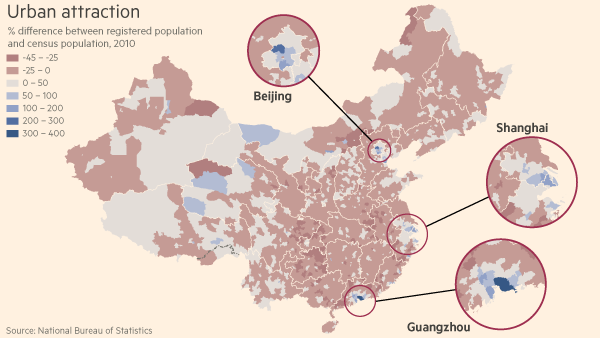Three things we learned from making a China migration choropleth
By Robin Kwong and Steve Bernard
The flow of labour from countryside to city in China has powered three decades of economic growth and engendered what is likely the biggest annual mammalian migration on earth.
The above map shows this shift on a county and city level based on data from China’s 2010 census. It shows the difference between the registered population of an area, and how many people the census takers actually found there in 2010.
We learnt three things from making this map:
- The scale of human movement captured by this map is staggering
Henan province, which had the biggest exodus (-10.25m), lost more than the entire population of Sweden (9.76m).While Guangdong province, which received the most migrants (+20.5m), gained more than the entire population of Romania (19.94m).
- Not everyone was rushing to move to the coastal cities
China’s more remote regions, such as Heilongjiang, Tibet, and Inner Mongolia actually had a net gain in their populations.
- As in Los Angeles, London or Paris, big Chinese cities sprawl.
By the 2010 census, people had been moving to Beijing, Shanghai and Guangdong for years, and the map shows clearly that the influx has spilled into neighbouring counties and satellite cities such as Danyang, Huzhou, and Hangzhou for Shanghai. (Hangzhou is 160km away from central Shanghai – or roughly the distance from London to Bristol)
But these things take time. Electronics manufacturers – who employ large armies of workers – were just starting to move inland to cheaper locations such as Chongqing (population: 28.8m ) in 2010.
Foxconn, for example, only produced its first laptop from its Chongqing plant on May 18 that year. As a result Chongqing’s gain in population, as shown on the map appear far less impressive, and the rural counties surrounding it remain a sea of red.
China is conducting its sixth ever national census at the end of 2015 – it’ll be interesting to see how the population of large inland cities such as Chongqing and Wuhan have changed in the last five years.
Additional reporting by Gabriel Wildau and Nan Ma in Shanghai




沒有留言:
張貼留言